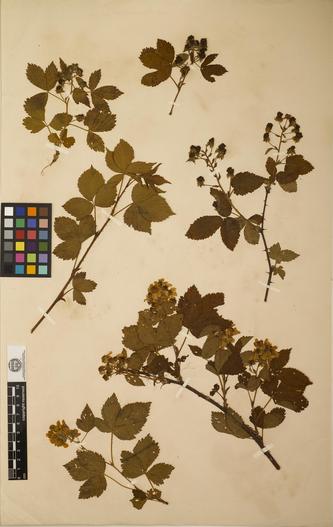Setose Blackberry
(Rubus ×setosus)
Setose Blackberry (Rubus ×setosus)
/
/

Harvard University Herbaria (HUH)
PDM 1.0
Image By:
Harvard University Herbaria (HUH)
Recorded By:
Copyright:
PDM 1.0
Copyright Notice:
Photo by: Harvard University Herbaria (HUH) | License Type: PDM 1.0 | License URL: https://creativecommons.org/publicdomain/mark/1.0/ | Uploader: Harvard University Herbaria | Publisher: Flickr
























Estimated Native Range
Summary
Rubus ×setosus, commonly known as Setose Blackberry, is a deciduous subshrub native to open woodlands and forest edges in the Northeastern USA and Eastern Canada. It typically grows to a height of 2-5 feet (0.6-1.5 meters) and a width of 3-6 feet (0.9-1.8 meters). The plant is characterized by its arching canes covered with fine bristles and its compound leaves with toothed leaflets. During the summer, it produces small, showy purple flowers followed by edible blackberries that are attractive to wildlife and can be used in culinary applications.
Setose Blackberry is valued for its fruit production and as a naturalizing plant in garden settings. It is often used in fruit gardens, as a border plant, or for wildlife habitats. This blackberry prefers part shade but can tolerate full sun if provided with adequate moisture. It requires soils with medium drainage and benefits from mulching to retain soil moisture and suppress weeds. While it is generally easy to maintain, it can become invasive if not managed properly, spreading through its rhizomes and self-seeding. Gardeners should be aware of its potential to spread and take measures to control its growth if necessary.CC BY-SA 4.0
Setose Blackberry is valued for its fruit production and as a naturalizing plant in garden settings. It is often used in fruit gardens, as a border plant, or for wildlife habitats. This blackberry prefers part shade but can tolerate full sun if provided with adequate moisture. It requires soils with medium drainage and benefits from mulching to retain soil moisture and suppress weeds. While it is generally easy to maintain, it can become invasive if not managed properly, spreading through its rhizomes and self-seeding. Gardeners should be aware of its potential to spread and take measures to control its growth if necessary.CC BY-SA 4.0
Plant Description
- Plant Type: Shrub
- Height: 2-5 feet
- Width: 3-6 feet
- Growth Rate: Moderate
- Flower Color: White
- Flowering Season: Spring, Summer
- Leaf Retention: Deciduous
Growth Requirements
- Sun: Full Sun, Part Shade
- Water: Medium
- Drainage: Medium
Common Uses
Bee Garden, Bird Garden, Butterfly Garden, Edible*Disclaimer: Easyscape's listed plant edibility is for informational use. Always verify the safety and proper identification of any plant before consumption., Hummingbird Garden, Low Maintenance
Natural Habitat
Open woodlands and forest edges
Other Names
Common Names:
Scientific Names: , Rubus ×setosus, Rubus nigricans, Rubus ×frondisentis, Rubus ×abbrevians, Rubus groutianus, Rubus ×aculiferus, Rubus ×ascendens, Rubus ×perspicuus, Rubus exter
GBIF Accepted Name: Rubus ×setosus Bigelow